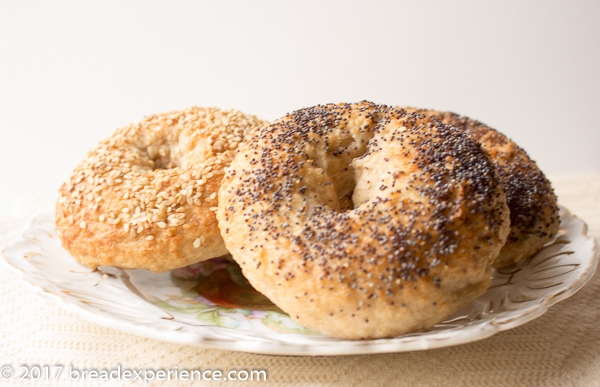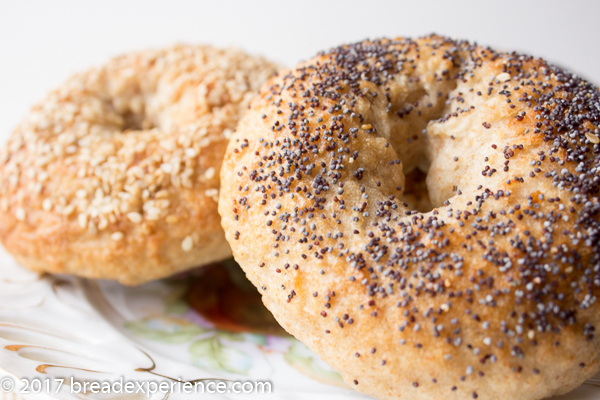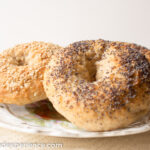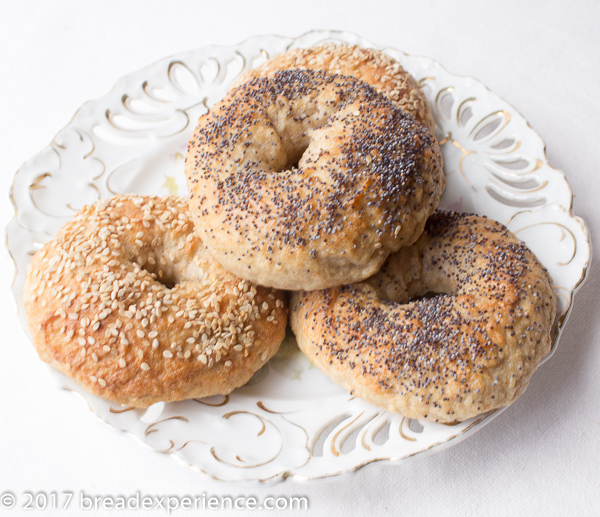I’ve been in bagel-making mode for the past few weeks. I started with Sourdough Kefir Milk Bagels with Sprouted Wheat and while I was making those, I decided it would be interesting to do a comparison of the same bagels made with different types of fermentation.
I made bagels using kefir milk, kefir water, kombucha, and sourdough. This post features Sourdough Kefir Water Bagels.

What is kefir water and why use it in bread?
Kefir water is a dairy-free, probiotic-rich fermented beverage. It can be made with sugar water, coconut water, or juice. It is a pleasant, fizzy drink that provides a healthier alternative to consuming commercial sodas.
I’ve been culturing sugar-water kefir for several months and found myself with more kefir water than I could shake a stick at. So I started looking for creative ways to use it.
I incorporated it in this bread for a few reasons: 1) to provide a dairy-free option for people who are milk-intolerant; 2) to test how kefir water would work as a fermentation method in bread; and 3) to use up some of the extra that was sitting in my refrigerator.
Because I had added sourdough to the kefir milk bagels, I also included it in these bagels to keep the variables the same, except for the type of fermentation used.

These bagels represent a deviation from the standard bagels you find in stores and perhaps even from ones you make at home. They have a hint of sweetness due to the sugar water, but it’s not too sweet. They are a little lighter, compared to the kefir milk-enriched bagels.
I enjoyed the uniqueness of these bagels and the fact that they provide a healthier alternative. If you are looking for a creative way to add additional probiotics to your diet, these just might do the trick.
You might enjoy these bagels made with different types of ferments
- Gluten-Free Bagels with Kefir Water
- Kefir Milk Asiago Spelt Semolina Bagels
- Kefir Milk Pumpkin Spelt Bagels Make a Delicious Treat
- Sourdough Kombucha Bagels with Sprouted Wheat
- Sourdough Bagels with Sprouted Wheat

Sourdough Kefir Water Bagels
Description
These sourdough kefir water bagels represent a deviation from the bagels you find in stores and perhaps even ones you make at home.
Ingredients
Bagels:
- 2 cups / 240 grams all-purpose flour
- 1 cup / 130 grams sprouted wheat flour
- 1 cup / 265 grams active, 100% hydration starter*
- 1 cup / 240 grams cold kefir water, + more if needed
- 1/4 teaspoon instant yeast, optional
- 1 3/4 teaspoons / 10 grams fine sea salt
- Sesame and poppy seeds for sprinkling, or the seeds of your choice
For boiling the bagels:
- 2 quarts water
- 1 1/2 tablespoons barley malt powder
- 1 tablespoon baking soda
- 1 3/4 teaspoons / 10 grams salt
Instructions
- In a large bowl, whisk together all of the dry ingredients: all-purpose flour, sprouted wheat flour, yeast (if using), and salt.
- Add the kefir water and starter to the dry ingredients and mix thoroughly using a Danish dough whisk or wooden spoon. When the dough becomes to thick to mix with the whisk or spoon; continue mixing with your hands until everything is thoroughly combined.
- Form the dough into a rough ball and place it in a lightly greased bowl. Cover with plastic wrap or a kitchen towel and let it proof in the bowl for a total of 2 hours.
- After the first hour, on a work surface sprinkled lightly with flour (or in the bowl), fold the dough onto itself from all 4 corners to strengthen the gluten structure. Form the dough into a ball again and place the dough back in the bowl; recover. Fold the dough again after the 2nd hour, and place it back in the bowl. Tightly cover and place in the refrigerator to retard overnight.
- The next day, or up to 48 hours later, remove the bowl from the refrigerator and allow the dough to warm up to room temperature.
- Divide the dough into 8 – 10 balls depending on how big you want the bagels. I formed them into 10 balls.Let the dough balls rest for 15 -20 minutes.
- Shape the balls into bagels by poking a hole in the middle of the ball with your finger. Gently widen the hole until it forms a ring. The bagels will continue to expand so make the holes a little larger than you think.
- Place the shaped bagels on a lightly greased baking sheet or a baking sheet covered with greased parchment paper. Set them aside for 30 minutes to 1 hour.
- Preheat the oven to 450 degrees F.
- Check to see if the bagels are ready to be boiled by performing a “float” test after 30 minutes. To do this, fill a small bowl with water and place one of the bagels in the water. If it floats, the bagels are ready to be boiled, if not, wait another 20 to 30 minutes.
- Prepare the poaching liquid by filling a large pot halfway with water and bringing it to a boil. Reduce to a simmer. Add 1 tbsp baking soda, 1 1/2 tbsp barley malt and 1 tsp salt.
- Using a large slotted spoon or tongs, gently lower a bagel top down into the simmering water. Let it simmer for 45 seconds, then flip over with the slotted spoon and let it simmer on the other side for about 30 seconds. Longer boiling results in a chewier bagel.
- Place the bagels on a wire rack to drain for a few seconds before placing them top side up on the baking sheet. Continue with the remaining bagels.
- Sprinkle the tops of the slightly wet bagels with the seeds of your choice.
- Transfer the baking sheet to the oven and bake for 8 – 10 minutes. Rotate the baking sheet and bake another 10 or so minutes until browned on top.
- Remove the bagels to a wire rack to cool 30 minutes before slicing and serving.
Notes
* The day before you plan to make these bagels, feed your sourdough starter, preferably in the morning so it will be ready to use when you make the dough in the afternoon or evening.
- Category: Bagels

Thank you for joining me on my bagel-making journey.
Happy Baking!
Cathy
Leave a Reply